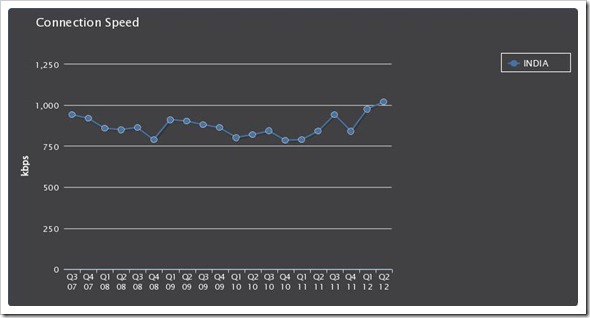Average Internet Connection Speed in India Crosses 1 Mbps for First Time [Akamai]
The average Indian internet connection speed in India is more than 1 Mbps, the highest till date, according to Akamai Technologies’ State of the Internet report for Q2 2012. It indicates a more than 21% growth as compared to the same period in 2011.
Indian Internet Connection Speed growth
At 14.2 Mbps, South Korea had the highest average connection speed in the world followed by Japan and Hong Kong with 10.7 Mbps and 8.9 Mbps respectively. Other countries among the top 10 were Latvia (8.7 Mbps), Switzerland (8.4 Mbps), Netherlands (8.0 Mbps), Czech Republic (7.2 Mbps), Denmark (6.7 Mbps), United States (6.6 Mbps) and Finland (6.6 Mbps).
Although Asian countries dominated the list there was a significant divide between the average connection speeds of leading countries like South Korea and others including India (1 Mbps), China (1.5 Mbps), Malaysia (2.2 Mbps), Philippines (1.2 Mbps) and Indonesia (770 kbps).
State of the Internet report also pegged India’s high speed broadband adoption rate at 0.15%, a QoQ growth of 10%. This indicated that less than 1% of India’s internet connections had average speeds exceeding 10 Mbps.
Internet connectivity in India has often been slammed by commentators for a low penetration rate and lack of broadband connectivity to the masses.
However many seem to be overlooking the enormous digital divide. Various estimates suggest that more than 70% of the broadband subscriber base in India is in the top 30 cities. Only 4.6% of rural India has internet access, according to industry body IAMAI.
Despite low percentage levels of penetration and connectivity, the absolute vastness of the Indian online domain in terms of numbers is hard to ignore. The 121 million plus online Indian population accounts for 5.3% of the world’s internet population. Internet connectivity in rural India saw a 73% jump in 2012 as compared to 2011, signaling strong growth.
The Indian government approved Rs. 20,000 crore for the National Optical Fibre Network (NFON) last year. The scheme will allow broadband penetration via BSNL into villages throughout the country. However the government’s attempt at bridging the massive digital divide will presumably not happen overnight.
In August this year, the UP government reportedly approved implementation of NFON across the state to allow broadband penetration up to gram panchayat levels. India’s broadband penetration levels along with average connection speeds will potentially see a major uptick once NFON is successfully implemented in a state whose population is more than 200 million or 20 crore.
As broadband connectivity and penetration in India grows, public and private sector enterprises are set to embrace e-initiatives on a larger scale in areas of governance, health, education, banking and other industries; and vice versa.


Great and Excellent article by author by gathering all information about the Internet Connection usage in India. But also still Indian Villages are not even known about landlines and broadband success to reach and cover all common people.